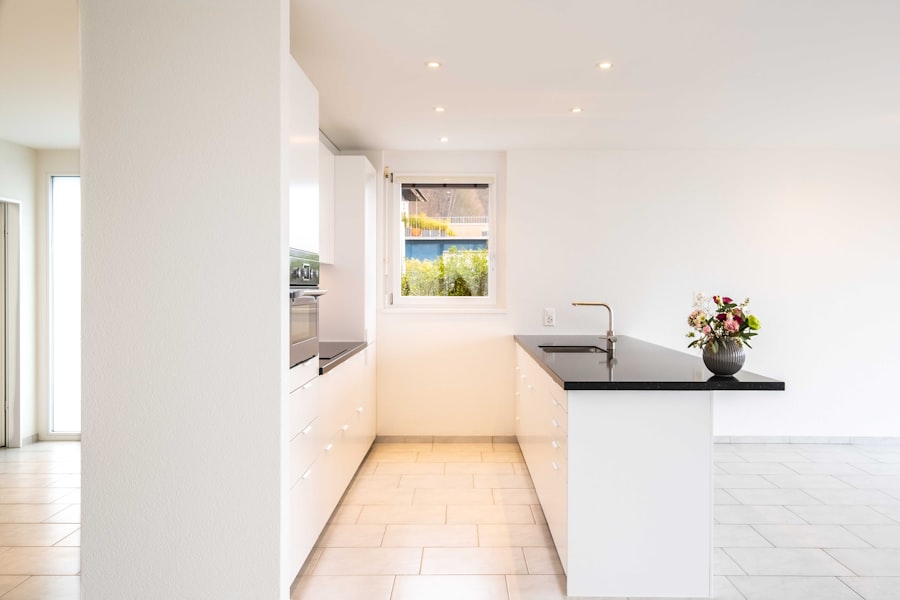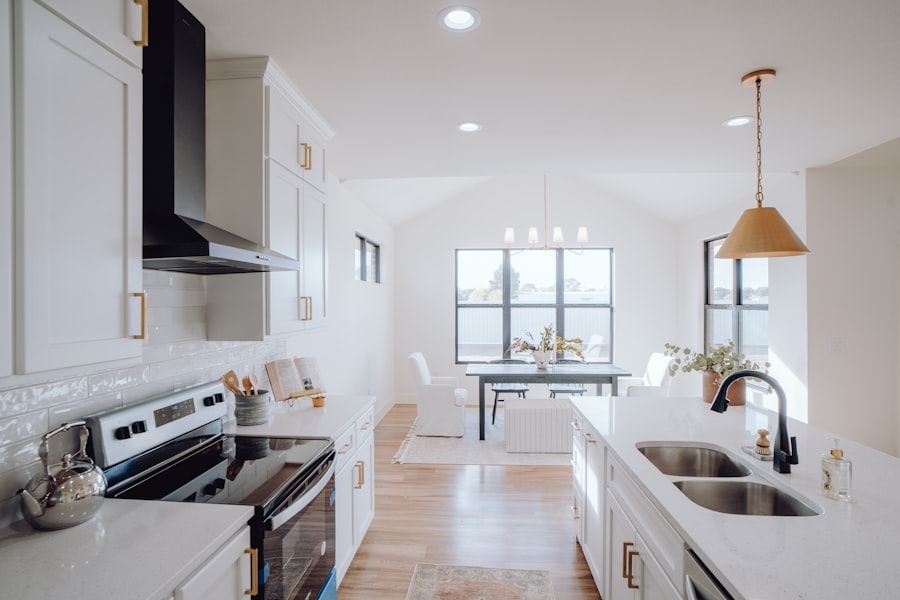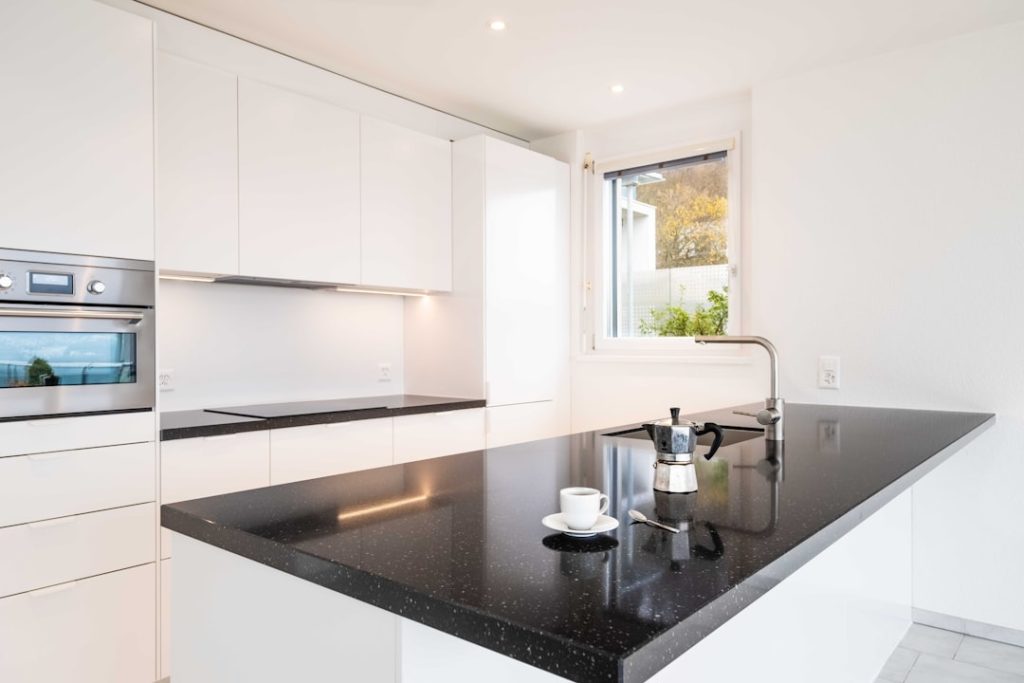One of the most transformative changes you can make in a kitchen is to paint the cabinets and walls. A fresh coat of paint can breathe new life into a space that may feel outdated or dull. When selecting colors, consider the overall aesthetic you wish to achieve.
For a modern look, shades of white, gray, or navy can create a sleek and sophisticated atmosphere. Alternatively, warmer tones like soft yellows or muted greens can evoke a cozy, inviting feel. The choice of color not only affects the mood of the kitchen but also influences how light interacts with the space, making it feel larger or more intimate.
In addition to choosing the right colors, the technique used in painting can significantly impact the final result. For cabinets, it’s essential to properly prepare the surfaces by cleaning, sanding, and priming before applying paint. This preparation ensures that the paint adheres well and lasts longer.
Using a high-quality paint designed for cabinetry can also enhance durability and provide a smooth finish. When painting walls, consider using a semi-gloss or satin finish in areas prone to splashes or stains, as these finishes are easier to clean. The combination of freshly painted cabinets and walls can create a cohesive look that elevates the entire kitchen.
Key Takeaways
- Painting cabinets and walls can instantly brighten and modernize a kitchen.
- Updating hardware and fixtures offers a quick, budget-friendly style boost.
- Adding open shelving creates more storage and showcases decorative items.
- Installing affordable countertops improves functionality without high costs.
- Utilizing peel-and-stick backsplash provides an easy, mess-free way to enhance kitchen design.
Update Hardware and Fixtures
Updating hardware and fixtures is a relatively simple yet highly effective way to modernize your kitchen without undertaking a full renovation. Swapping out old cabinet knobs and drawer pulls for more contemporary options can dramatically change the look of your cabinetry. For instance, brushed nickel or matte black finishes are currently trending and can add a touch of elegance to your kitchen.
Additionally, consider the style of your home when selecting hardware; for example, vintage-style knobs may complement a farmhouse kitchen, while sleek, minimalist designs work well in modern spaces. Beyond cabinet hardware, updating faucets and light fixtures can also enhance functionality and aesthetics. A new faucet with a pull-down sprayer not only looks stylish but also improves usability when washing dishes or preparing food.
Similarly, pendant lights over an island or dining area can serve as both functional lighting and a design statement. When choosing fixtures, pay attention to scale; oversized fixtures can overwhelm a small kitchen, while too-small options may get lost in a larger space. By thoughtfully selecting hardware and fixtures, you can create a cohesive design that reflects your personal style.
Add Open Shelving

Open shelving has gained popularity in recent years as a way to showcase beautiful dishware and decorative items while also creating an open and airy feel in the kitchen. Unlike traditional cabinets that can make a space feel closed off, open shelves invite light and provide an opportunity to display your favorite items. When considering open shelving, think about the materials and colors that will best complement your existing cabinetry and decor.
For instance, wooden shelves can add warmth and texture, while metal shelves may contribute to a more industrial vibe. In addition to aesthetics, open shelving encourages organization and accessibility. By displaying frequently used items like plates, glasses, and cookbooks, you can streamline your cooking process and reduce clutter on countertops.
However, it’s essential to maintain order on open shelves; consider using baskets or decorative boxes to store smaller items neatly. Regularly rotating displayed items can also keep the look fresh and engaging. Open shelving not only enhances functionality but also allows for personal expression through curated displays.
Install Affordable Countertops
| Countertop Material | Average Cost per Sq Ft | Durability Rating (1-10) | Installation Time (Hours) | Maintenance Level | Typical Lifespan (Years) |
|---|---|---|---|---|---|
| Laminate | 15 | 5 | 4 | Low | 10-15 |
| Butcher Block | 30 | 6 | 6 | Medium | 10-20 |
| Ceramic Tile | 20 | 7 | 8 | Medium | 15-25 |
| Solid Surface (e.g. Corian) | 40 | 7 | 5 | Low | 15-20 |
| Concrete | 35 | 8 | 10 | Medium | 20-30 |
| Recycled Glass | 45 | 7 | 6 | Low | 20-25 |
Countertops are one of the most significant elements in a kitchen, both in terms of functionality and visual impact. While natural stone options like granite or marble are often seen as luxurious choices, there are many affordable alternatives that can provide a similar aesthetic without breaking the bank. For example, laminate countertops have come a long way in terms of design and durability; they now come in various colors and patterns that mimic the look of natural stone.
Additionally, quartz countertops offer a non-porous surface that is resistant to stains and scratches while being available at various price points. Another budget-friendly option is butcher block countertops, which add warmth and character to any kitchen. They are particularly appealing for those who enjoy cooking, as they provide an excellent surface for food preparation.
To maintain butcher block countertops, regular oiling is necessary to prevent drying out and cracking. When selecting countertops, consider not only the cost but also how each material will fit into your lifestyle and maintenance preferences. By choosing affordable yet stylish countertops, you can significantly enhance the overall look of your kitchen.
Utilize Peel-and-Stick Backsplash
Peel-and-stick backsplash tiles have revolutionized kitchen renovations by offering an easy and cost-effective way to add visual interest without the need for professional installation. These adhesive tiles come in various designs, including classic subway tiles, intricate mosaics, or even bold patterns that can serve as a focal point in your kitchen. The application process is straightforward; simply peel off the backing and stick the tiles directly onto the wall.
This DIY approach not only saves money but also allows for quick updates that can be completed in just a few hours. When selecting peel-and-stick tiles, consider how they will coordinate with your existing color scheme and materials. For instance, if you have dark cabinetry, a light-colored backsplash can create contrast and brighten the space.
Alternatively, if you prefer a more cohesive look, choose tiles that match or complement your countertops or cabinetry. The versatility of peel-and-stick backsplashes means you can easily change them out if you decide to refresh your kitchen’s look in the future without the hassle of traditional tile installation.
Upgrade Lighting

Lighting plays a crucial role in both functionality and ambiance within a kitchen. An effective lighting scheme combines task lighting for work areas with ambient lighting for overall illumination. Consider replacing outdated ceiling fixtures with modern chandeliers or pendant lights that not only provide adequate light but also serve as decorative elements.
Dimmable options allow you to adjust brightness levels based on the time of day or occasion, creating an inviting atmosphere for family gatherings or dinner parties. In addition to overhead lighting, under-cabinet lighting is an excellent way to enhance visibility on countertops while adding depth to your kitchen design. LED strip lights are energy-efficient and easy to install; they can be placed directly under cabinets to illuminate workspaces without creating harsh shadows.
Incorporating various layers of lighting will not only improve functionality but also highlight architectural features or decorative elements within your kitchen.
DIY Kitchen Island
A kitchen island can serve as a multifunctional space for cooking, dining, or entertaining guests. If your kitchen lacks an island or if you want to create additional workspace without spending a fortune, consider building a DIY kitchen island. This project allows for customization based on your specific needs and available space.
You could use repurposed materials like old furniture or pallets to create a unique piece that fits seamlessly into your kitchen’s design. When designing your DIY island, think about its intended use; will it primarily serve as extra counter space for meal prep, or do you envision it as a casual dining area? Incorporating storage solutions such as shelves or cabinets can maximize functionality while keeping clutter at bay.
Additionally, adding bar stools or chairs will create an inviting spot for family members to gather while meals are being prepared. A well-designed DIY kitchen island not only enhances usability but also becomes a focal point that reflects your personal style.
Refresh Flooring
The flooring in your kitchen significantly impacts both aesthetics and functionality. Over time, wear and tear can make even the most beautiful floors look tired and outdated. If you’re looking for an affordable way to refresh your kitchen’s appearance, consider options like vinyl plank flooring or laminate that mimic the look of hardwood without the high cost or maintenance requirements associated with real wood.
These materials are durable, water-resistant, and available in various styles that can suit any design preference. For those seeking a more eco-friendly option, cork flooring is another excellent choice; it’s sustainable, comfortable underfoot, and provides natural insulation against temperature changes. Additionally, area rugs can be used strategically in high-traffic zones to add warmth and color while protecting the underlying flooring from damage.
By carefully selecting flooring materials that align with your lifestyle needs and aesthetic preferences, you can create a cohesive look that enhances both comfort and style in your kitchen space.




